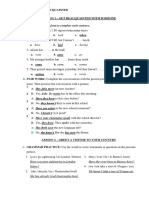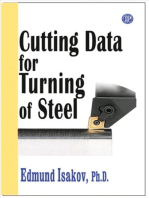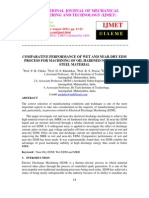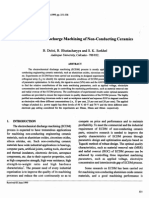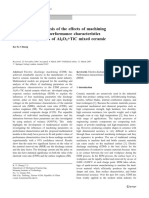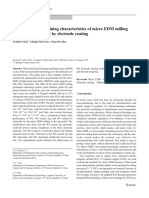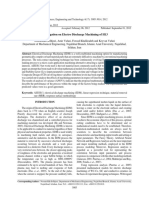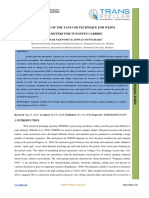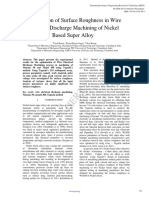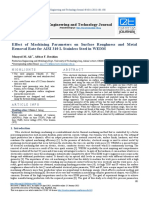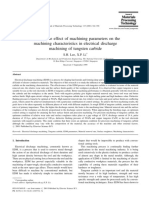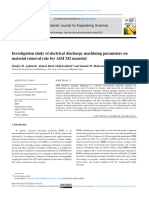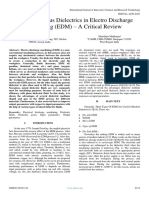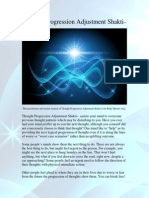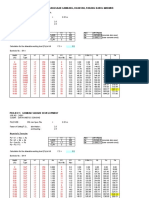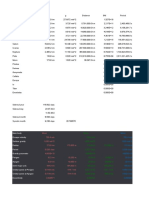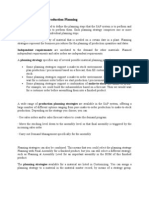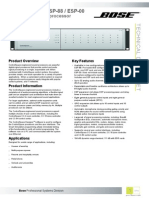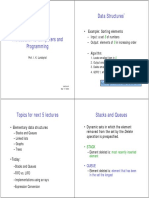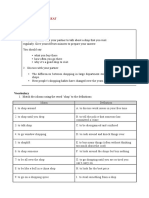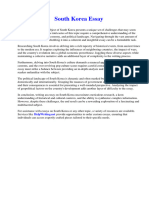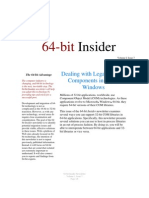IMECS2009 pp1803-1808
IMECS2009 pp1803-1808
Uploaded by
Ratan KumarCopyright:
Available Formats
IMECS2009 pp1803-1808
IMECS2009 pp1803-1808
Uploaded by
Ratan KumarOriginal Title
Copyright
Available Formats
Share this document
Did you find this document useful?
Is this content inappropriate?
Copyright:
Available Formats
IMECS2009 pp1803-1808
IMECS2009 pp1803-1808
Uploaded by
Ratan KumarCopyright:
Available Formats
Proceedings of the International MultiConference of Engineers and Computer Scientists 2009 Vol II IMECS 2009, March 18 - 20, 2009,
Hong Kong
Analysis of the Influence of EDM Parameters on Surface Quality, Material Removal Rate and Electrode Wear of Tungsten Carbide
1
S.H.Tomadi, 1M.A.Hassan, 2Z. Hamedon, Member, IAENG 1R.Daud, 1A.G.Khalid
Abstract: Electrical discharge machining (EDM) is a process for shaping hard metals and forming deep complex shaped holes by arc erosion in all kinds of electro-conductive materials. The objective of this paper is to study the influence of operating parameters of tungsten carbide on the machining characteristics such as surface quality, material removal rate and electrode wear. It is followed by optimizing the machining condition for confirmation test purposes. Then, the conformation test needed to evaluate the error margin between predicted result by software and confirmation result by experiment in terms of the machining characteristics. The effectiveness of EDM process with tungsten carbide, WC-Co is evaluated in terms of the material removal rate, the relative wear ratio and the surface finish quality of the workpiece produced. It is observed that copper tungsten is most suitable for use as the tool electrode in EDM of WC-Co. Better machining performance is obtained generally with the electrode as the cathode and the workpiece as an anode. In this paper, a study was carried out on the influence of the parameters such peak currrent, power supply voltage, pulse on time and pulse off time. The surface quality that was investigated in this experiment was surface roughness using perthometer machine. Material removal rate (MRR) and electrode wear (EW) in this experiment was calculated by using mathematical method. The result of the experiment then was collected and analyzed using STATISTICA software. This was done by using the design of experiments (DOE) technique and ANOVA analysis. Index Terms ANOVA Analysis, EDM Parameters, Electrode Wear, Material Removal Rate, STATISCA,
I. INTRODUCTION
Faculty of Mechanical Engineering, Universiti Malaysia Pahang, Lebuhraya Tun Razak, 26300, Kuantan, Pahang, Malaysia. Phone: +6095492216; Fax: +6095492244 Email: sharyani@ump.edu.my
2 Faculty of Manufacturing Engineering and Technology Management, Universiti Malaysia Pahang, Lebuhraya Tun Razak, 26300, Kuantan, Pahang, Malaysia.
Electrical Discharge Machining (EDM) is a nontraditional manufacturing process based on removing material from a part by means of a series of repeated electrical discharges (created by electric pulse generators at short intervals) between a tool, called electrode, and the part being machined in the presence of a dielectric uid [1]. At present, EDM is a widespread technique used in industry for highprecision machining of all types of conductive materials such as metals, metallic alloys, graphite, or even some ceramic materials. The adequate selection of manufacturing conditions is one of the most important aspects to take into consideration in the die-sinking electrical discharge machining (EDM) of conductive steel, as these conditions are the ones that are to determine such important characteristics: surface roughness, electrode wear (EW) and material removal rate (MRR). In this paper, a study will be perform on the inuence of the factors of peak current, pulse on time, interval time and power supply voltage. The material used in this study is a tungsten carbide or hard metal such as WC15%Co. Approximately 50% of all carbide production is used for machining applications but tungsten carbides are also being increasingly used for nonmachining applications, such as mining, oil and gas drilling, metal forming and forestry tools. [7] Accordingly, mathematical models will be obtained using design of experiments (DOE) technique to select the optimum machining conditions for machining WC-Co using EDM. The objectives of this paper are stated as follows: To evaluate the performance of EDM on tungsten carbide(WC) with respect to various responses such as surface quality, electrode wear(EW) and material removal rate(MRR) To establish mathematical model for all responses involved which are surface quality, material removal rate (MRR) and electrode wear (EW). Full factorial method from design of experiment (DOE) used in order to analyze and determine global solutions for optimal cutting parameters of EDM operation.
ISBN: 978-988-17012-7-5
IMECS 2009
Proceedings of the International MultiConference of Engineers and Computer Scientists 2009 Vol II IMECS 2009, March 18 - 20, 2009, Hong Kong
II. LITERATURE REVIEW
4) Duty cycle : It is a percentage of the on-time relative to the total cycle time. This parameter is calculated by dividing the on-time by the total cycle time (on-time plus off-time). The result is multiplied by 100 for the percentage of efficiency or the so called duty cycle. 5) Intensity (I): It points out the different levels of power that can be supplied by the generator of the EDM machine. (I) represents the mean value of the discharge current intensity. EDM performance, regardless of the type of the electrode material and dielectric fluid, is measured usually by the following criteria: 1) Metal removal rate (MRR) Maximum of MRR is an important indicator of the efficiency and cost effectiveness of the EDM process, however increasing MRR is not always desirable for all applications since this may scarify the surface integrity of the workpiece. A rough surface finish is the outcome of fast removal rates. [6] 2) Resistance to wear or electrode wear (EW) The electrode wear also depends on the dielectric flow in the machining zone. If the flow is too turbulent, it results in an increase in electrode wear. Pulsed injection of the dielectric has enable reduction of wear due to dielectric flow. [2] 3) Surface Roughness (Ra) of workpiece The surface produced by EDM process consists of a large number of craters that are formed from the discharge energy. The quality of surface mainly depends upon the energy per spark.
III. EXPERIMENTAL METHOD
Electrical Discharge Machining (EDM) - Die Sink is one of the most extensively used non-conventional material removal processes. Its unique feature of using thermal energy to machine electrically conductive parts regardless of hardness has been its distinctive advantage in the manufacture of mould, die, automotive, aerospace and surgical components. In addition, EDM does not make direct contact between the electrode and the workpiece eliminating mechanical stresses, chatter and vibration problems during machining. [2] Based on Yussni (2008), the variables parameters are have great effects to the machining performances results especially to the material removal rate (MRR), electrode wear rate and surface quality. There are two major groups of parameters that have been discovered and categorized [2]: 1) Non-electrical Parameters a. Injection flushing pressure b. Rotational of speed electrode 2) Electrical Parameters a. Peak current b. Polarity c. Pulse duration d. Power supply voltage In the other hand, Van Tri (2002) categorized the parameters into five groups: [5] 1) Dielectric fluid; type of dielectric, temperature, pressure, flushing system 2) Machine characteristics; servo system and stability stiffness, thermal stability and accuracy 3) Tool; material, shape, accuracy 4) Workpiece 5) Adjustable parameters; discharge current, gap voltage, pulse duration, polarity, charge frequency, capacitance and tool materials Some of the most important parameters implicated in the EDM manufacturing process are the following ones [2]: 1) On-time (pulse time or ti): The duration of time (s) the current is allowed to flow per cycle. Material removal is directly proportional to the amount of energy applied during this on-time. This energy is really controlled by the peak current and the length of the on-time. 2) Off-time (pause time or t0): It is the duration of time (s) between the sparks (that is to say, on-time). This time allows the molten material to solidify and to be wash out of the arc gap. This parameter is to affect the speed and the stability of the cut. Thus, if the off-time is too short, it will cause sparks to be unstable. 3) Arc gap (or gap): It is the distance between the electrode and the part during the process of EDM. It may be called as spark gap.
A. Material used Tungsten Carbide WC15Co Tungsten Carbide has been selected as the workpiece for this experiment, which means that it has a proportion of cobalt of 15%. Based on the Mikael Christensen and Gran Wahnstrm(2005), Tungsten carbide,with 15% cobalt content are a class of hard composite materials of great technological importance. They are widely used as tool materials in a large variety of applications where the demands on hardness and toughness are high, including such as mining, turning, cutting and milling [4] and table 1 shows the workpiece material properties
ISBN: 978-988-17012-7-5
IMECS 2009
Proceedings of the International MultiConference of Engineers and Computer Scientists 2009 Vol II IMECS 2009, March 18 - 20, 2009, Hong Kong
Table 1: Workpiece material properties [8]
EW = EWW x 100% WRW where: EWW = weight of electrode used (g) WRW = weight of workpiece used (g) D. Surface Roughness Measurement
(1)
There are various methods available for measuring the surface roughness of the workpiece. The arithmetic surface roughness value (Ra) will be adopted and measurements will be carried out at the bottom and at the side wall of the holes using a Mahrsurf XR 20 Perthometer. B. Material Cutting Designation
IV. RESULTS AND DISCUSSION
A. Surface Roughness, Ra Analysis In this paper, copper tungsten will be used as an electrode material. This copper tungsten (CuW) rod had 8 mm of diameter and table 2 shows the specification. Table 2: Electrode material properties With full factorial as a design of experiment, value of surface roughness for each sample will be obtained. Then, STATISTICA software will be used for further analysis. Figure 1 to 4 shows all the result.
Specification Density(g/cm) Coefficient Composition Hardness
Value 15.2 of 5 x 10-4 75% Tungsten, 25% 94 HRB, 18 HRC
Specific resistance 5.5
C. Material Removal Rate Measurement The MRR of the workpiece will be measure by dividing the weight of workpiece before and after machining (found by weighing method using balance) against the machining time that was achieved. After completion of each machining process, the workpiece was blown by compressed air using air gun to ensure no debris and dielectrics were present. A precise balance (Precisa 92SM 202A DR) will be use to measure the weight of the workpiece required. D. Electrode Wear Definition The concept of EW can be defined in many ways, the present study define the EW according to the ratio in weight of the electrode and the workpiece where expressed as percentage. Similar procedure for measuring the weight of workpiece will be used to determine the weight of the electrode before and after machining. The following equation is used to determine the EW value:
Figure 1: Graph of Surface Roughness, Ra versus Pulse off Time, (s)
Figure 2: Graph of Surface Roughness, Ra versus Voltage
ISBN: 978-988-17012-7-5
IMECS 2009
Proceedings of the International MultiConference of Engineers and Computer Scientists 2009 Vol II IMECS 2009, March 18 - 20, 2009, Hong Kong
Figure 6: 2-D fitted surface distribution of effect between two factors B. Material Removal Rate, MRR Analysis According to Figure 7, it shows that the higher Pulse On time will gives the higher value of MRR of WC-Co. Figure 8 shows that when the voltage is increased, the MRR will follow increased. Other than that, figure 9 shows that the result of graph is similar with figure 8; when the peak current is increased, MRR will follow increase. For the Figure 10 shows that the increasing of pulse off time, will decrease the MRR but it does not give significant effect to MRR, because the effect is too small.
Figure 3: Graph of Surface Roughness, Ra versus Peak Current (A)
Figure 4: Graph of Surface Roughness, Ra, versus Pulse on Time (s) Figure 5 present a three-dimensional surface plot of the data for pulse on time, 5 (s) and peak current, 7 A. Notice that the effect of the interaction between pulse off time, (s) and voltage (V) in the data is twist plane, so that there is curvature in the response function to the surface roughness. If the data contain no interaction, the surface plot is a plane lying above the peak current and pulse on time.
Fitted Surf ace; Variable: Surf ace roughness (m) 2**(4-0) design; MS Residual=.0312777 DV: Surf ace roughness (m)
Figure7: Graph of Material removal rate,MRR versus Pulse on Time, (s)
2 1.9 1.8 1.7 1.6 1.5 1.4
Figure 5: 3-D surface plots of the main effects of the voltage and pulse off time While, figure 6 shows the two dimensional with the distribution effect of surface roughness
Figure 8: Graph of Material removal rate,MRR versus voltage(V)
ISBN: 978-988-17012-7-5
IMECS 2009
Proceedings of the International MultiConference of Engineers and Computer Scientists 2009 Vol II IMECS 2009, March 18 - 20, 2009, Hong Kong
C. Electrode Wear (EW) Analysis According to Figure 12, it shows that the higher Pulse Off time will gives the low EW of WC-Co. Figure 13 shows that the result of the graph is different with the result in Figure 12; when the peak current are increased the electrode wear will followed increased. Other than that, figure 14 shows the result of graph same with figure 15 because when the voltage and pulse on time increased, the EW will also increase. For the figure 14 and figure 15 shows that these factors does not give significant effect to EW, because the graph is almost flat. Figure 9: Graph of Material removal rate, MRR versus peak current (A) From Figure 16 present a three-dimensional surface plot of the data for voltage, 11V and pulse on time, 5 s. Notice that the effect of the interaction between peak current, and pulse off time, (s) in the data is twist plane, so that there is curvature in the response function to the electrode wear. If the data contain no interaction, the surface plot is a plane lying above the peak current and pulse off time.
Figure 10: Graph of Material removal rate,MRR, versus Pulse off Time, (s) Figure 11 will shows a three-dimensional surface plot of data for peak current, 10 A and pulse off time, 5 s. There is showing the effect of the interaction between pulse on time and voltage but the higher voltage gives the higher value of MRR. So, there is curvature in the response function to the MRR. Invert with the pulse on time because the maximum pulse on time result shows the low value of MRR.
Figure 12: Graph of Electrode Wear versus Pulse off Time (s)
Figure 13: Graph of Electrode wear versus Peak current, (A)
Figure 11: 3-D surface plots of the main effects of the voltage and pulse on time
ISBN: 978-988-17012-7-5
IMECS 2009
Proceedings of the International MultiConference of Engineers and Computer Scientists 2009 Vol II IMECS 2009, March 18 - 20, 2009, Hong Kong
Figure 14: Graph of Electrode Wear, EW versus voltage, (V)
condition of parameters, main effect, and the significance of individual parameter to surface roughness, material removal rate and electrode wear of material. In the case of the Ra parameter, the most influential factors were voltage followed by the pulse off time, while the peak current and pulse on time was not significant at the considered confidence level. In order to obtain a good surface finish in the case of tungsten carbide, low values should be used for peak current, pulse off time and voltage. In the case of material removal rate, it was seen that pulse on time factor was the most influential, followed by voltage, peak current, and pulse off time. In order to obtain high values of material removal rate for the case of tungsten carbide, within the work interval considered in this study, one should use, high values for peak current and voltage. Finally, in the case of electrode wear, it was observed that the most influential were pulse off time, followed by the peak current factor. Therefore, in order to be able to obtain low values of electrode wear, high values of the pulse off time and low values peak current should be used.
REFERENCES
Figure 15: Graph of Electrode Wear, EW versus Pulse on Time, (s)
Figure 16: 3-D surface plots of the main effects of the peak current and pulse on time
V. CONCLUSION
[1]Pandey, P.C., and Shah, H.S. (1980). Modern Machining Processes. New Delhi. Tata Mcgraw-Hill. [2]Mr. Mohd Yussni Bin Yaakob(2008).Electrical Discharge Machining-Die Sinking.Universiti Tun Hussein On Malaysia (UTHM). [3] S. H. Lee and X. P. Li,(2001).Study of the effect of machining parameters on the machining characteristics in electrical discharge machining of tungsten carbide, The National University of Singapore [4] Mikael Christensen and Gran Wahnstrm*(2005).Interfacecontrolled properties of WC-Co cemented carbides ; Department of Applied Physics, Chalmers University of Technology, SE-412 96 Gteborg, Sweden [5]Van Tri, N. (2002). Electrical discharge machining of aluminum alloy using classical design of experiment approach. Universiti Teknologi Malaysia: Master Thesis. [6]Puertas, I., and Perez , C.J .L. (2003). Modelling the Manufacturing Parameters in Electrical Discharge Machining of Siliconiz ed Silicon Carbide. Proceedings of the Institution of Mecahnical Engineers. Proq uest Science J ournals. 217, 6; 791- 803 [7]Puertas, I., Luis, C.J . and Alvarez , L. (2004). Analysis of the Influence of EDM Parameters on Surface Quality , MRR and EW of WC-Co. Journal of Material Processing Technology. [8]Mahajan, V.K. (1981). Tool & Die Maker. New Delhi: Tata McGraw-Hill [9]Wong, Y .S., Lim, L.C., and Lee, L.C. (1995). Effect of Flushing on Electro Discharge Machined Surface. J. of Materials Processing Technology. 48: 299-305 [10]Sommer, C. (2000). Non-traditional machining handbook. First edition. Advance Publishing. Houston. [11]Noordin M.Y . (2003). Performance Evaluation of Coated Carbide Cermet Tools When Turning Hardened Tool Steel. PhD Thesis. Universiti Teknologi Malaysia [12]Montgomery, D.C. (2001). Design and analysis of experiments. Fifth edition. J ohn Wiley & Sons,New York [13]Diamond, W.J . (2001). Practical experiment design for engineers and scientists. Third edition. John Wiley & Sons. New York [14]Lochner, R.H., and Matar, J .E. (1990). Designing for quality; an introduction to the best of Taguchi and Western methods of statistical experiment design. Chapman and Hall, New York.
Basically, this investigation is successful achieved the objective with the acceptable outcome. This experiment evaluates the machining of Tungsten Carbide with a Copper Tungsten as electrode. The Full Factorial Design of Experiment (DOE) is very useful in analyzing the optimum
ISBN: 978-988-17012-7-5
IMECS 2009
You might also like
- Top Notch 2 ThreeDocument17 pagesTop Notch 2 ThreeLupita Allaico76% (17)
- IMECS2009 pp1803-1808Document6 pagesIMECS2009 pp1803-1808neerajNo ratings yet
- A Study of Electrical Discharge Grinding Using A Rotary Disk ElectrodeDocument9 pagesA Study of Electrical Discharge Grinding Using A Rotary Disk ElectrodeSarath ChandraNo ratings yet
- Ijmet: ©iaemeDocument8 pagesIjmet: ©iaemeIAEME PublicationNo ratings yet
- An Investigation To Achieve A Good Surface IntegriDocument23 pagesAn Investigation To Achieve A Good Surface IntegriashadoitNo ratings yet
- Investigating Effects of Process Variables On MRR in EDM by Using Taguchi Parameter Design ApproachDocument6 pagesInvestigating Effects of Process Variables On MRR in EDM by Using Taguchi Parameter Design ApproachPujara ManishNo ratings yet
- AFM Surface Investigation of Inconel 825 With Multi Wall Carbon Nano Tube in Electrical Discharge Machining Process Using Taguchi AnalysisDocument22 pagesAFM Surface Investigation of Inconel 825 With Multi Wall Carbon Nano Tube in Electrical Discharge Machining Process Using Taguchi AnalysisBalu BhsNo ratings yet
- A Brief Review of Die Sinking Electrical Discharging Machining Process Towards AutomationDocument7 pagesA Brief Review of Die Sinking Electrical Discharging Machining Process Towards AutomationMayank Rajesh Kumar ShrivastavaNo ratings yet
- Comparative Performance of Wet and Near-Dry Edm Process For Machining of Oil Hardned Non Sinking Steel MaterialDocument10 pagesComparative Performance of Wet and Near-Dry Edm Process For Machining of Oil Hardned Non Sinking Steel MaterialIAEME PublicationNo ratings yet
- Electric Discharge Machining Method ForDocument12 pagesElectric Discharge Machining Method Forraviteja tankalaNo ratings yet
- Kung2009 Article MaterialRemovalRateAndElectrod PDFDocument10 pagesKung2009 Article MaterialRemovalRateAndElectrod PDFAkasapu SaisreeharshaNo ratings yet
- Parametric Optimization of Electrochemical Machining Using Signal-To-Noise (S/N) RatioDocument8 pagesParametric Optimization of Electrochemical Machining Using Signal-To-Noise (S/N) RatioIJMERNo ratings yet
- 3846 11259 1 SM PDFDocument8 pages3846 11259 1 SM PDFKaustav Roy ChoudhuryNo ratings yet
- Drilling of CFRP by EDMDocument10 pagesDrilling of CFRP by EDMthasarathanr1993_939No ratings yet
- ECDMDocument8 pagesECDMSaurabhBhardwajNo ratings yet
- Optimization of Various Machining Parameters of Electrical Discharge Machining (EDM) Process On AISI D2 Tool Steel Using Hybrid Optimization MethodDocument9 pagesOptimization of Various Machining Parameters of Electrical Discharge Machining (EDM) Process On AISI D2 Tool Steel Using Hybrid Optimization MethodInternational Journal of Application or Innovation in Engineering & ManagementNo ratings yet
- Metallurgical Alterations in The Surface of Steel Cavities Machined by EDMDocument8 pagesMetallurgical Alterations in The Surface of Steel Cavities Machined by EDMDeak Ferenc-JozsefNo ratings yet
- Modeling and Analysis of The Effects of Machining Parameters On The Performance Characteristics in The Edm Process of Al O +tic Mixed CeramicDocument11 pagesModeling and Analysis of The Effects of Machining Parameters On The Performance Characteristics in The Edm Process of Al O +tic Mixed CeramicusbkitsNo ratings yet
- Analysis of Influence of micro-EDM Parameters On MRR, TWR and Ra in Machining Ni-Ti Shape Memory AlloyDocument6 pagesAnalysis of Influence of micro-EDM Parameters On MRR, TWR and Ra in Machining Ni-Ti Shape Memory AlloyJanak ValakiNo ratings yet
- Electrode CoatingDocument8 pagesElectrode CoatingSaurabh JainNo ratings yet
- Electrical Discharge Machine (Edm) PDFDocument65 pagesElectrical Discharge Machine (Edm) PDFsujayan2005100% (3)
- Investigation On Electro Discharge Machining of H13Document10 pagesInvestigation On Electro Discharge Machining of H13Nguyễn Hữu PhấnNo ratings yet
- Optimization of Process Parameters in Wedm Process On Two Workpieces of Materials Hardox-400 and Hardox-500Document12 pagesOptimization of Process Parameters in Wedm Process On Two Workpieces of Materials Hardox-400 and Hardox-500TJPRC PublicationsNo ratings yet
- 1114meij04 PDFDocument9 pages1114meij04 PDFAli RazaNo ratings yet
- Application of Metal Powder To Improve Metal Removal Rate inDocument7 pagesApplication of Metal Powder To Improve Metal Removal Rate inan30No ratings yet
- Experimental Investigations On The Influence of Discharge CurrentDocument13 pagesExperimental Investigations On The Influence of Discharge CurrentChoy Hau YanNo ratings yet
- Ijmet: ©iaemeDocument9 pagesIjmet: ©iaemeIAEME PublicationNo ratings yet
- EDMDocument20 pagesEDMlogeshboy007No ratings yet
- Experimental Investigation and Multi-Objective Optimization of Wire Electrical Discharge Machining (WEDM) of 5083 Aluminum AlloyDocument7 pagesExperimental Investigation and Multi-Objective Optimization of Wire Electrical Discharge Machining (WEDM) of 5083 Aluminum AlloyÐɤ Suman ChatterjeeNo ratings yet
- Msword&Rendition 1Document22 pagesMsword&Rendition 1ashwini yewaleNo ratings yet
- Kerf WidthDocument6 pagesKerf WidthlarryNo ratings yet
- A Review On Current Research Trends in Electrical Discharge Machining (EDM)Document15 pagesA Review On Current Research Trends in Electrical Discharge Machining (EDM)dinesh veerNo ratings yet
- Effect of Current On EDMDocument58 pagesEffect of Current On EDMAli M. ElghawailNo ratings yet
- Application of The Taguchi Technique For Wedm Parameters For Tungsten CarbideDocument10 pagesApplication of The Taguchi Technique For Wedm Parameters For Tungsten CarbideTJPRC PublicationsNo ratings yet
- Ijert Ijert: Optimization of Surface Roughness in Wire Electrical Discharge Machining of Nickel Based Super AlloyDocument5 pagesIjert Ijert: Optimization of Surface Roughness in Wire Electrical Discharge Machining of Nickel Based Super AlloyuniquetechvideosNo ratings yet
- Optimization of Process Parameters in Die Sinking EDM - A REVIEWDocument6 pagesOptimization of Process Parameters in Die Sinking EDM - A REVIEWIJSTENo ratings yet
- RAPIDTOOLINGPAPERDocument9 pagesRAPIDTOOLINGPAPERabhishek.khairnar21No ratings yet
- Studying The Affect of Current On (MRR) and (EW) in Electrical Discharge Machining (EDM)Document15 pagesStudying The Affect of Current On (MRR) and (EW) in Electrical Discharge Machining (EDM)Mostafa AdilNo ratings yet
- InfluenceofProcessingParametersonMaterialRemovalRateToolWearRateandSurfaceRoughnessinElectro DischargeMachiningDocument11 pagesInfluenceofProcessingParametersonMaterialRemovalRateToolWearRateandSurfaceRoughnessinElectro DischargeMachiningTapas ChakrabortyNo ratings yet
- ETJ - Volume 40 - Issue 1 - Pages 181-188Document8 pagesETJ - Volume 40 - Issue 1 - Pages 181-188Jabbar AljanabyNo ratings yet
- Lee 2001Document15 pagesLee 2001vijayaragavanNo ratings yet
- Parameter Optimization of Electro Discharge Machine of AISI 304 Steel by Using Taguchi MethodDocument5 pagesParameter Optimization of Electro Discharge Machine of AISI 304 Steel by Using Taguchi MethodInternational Journal of Application or Innovation in Engineering & ManagementNo ratings yet
- Parametric Study of Dry WEDM Using Taguchi Method: S.Boopathi, K.Sivakumar, R.KalidasDocument6 pagesParametric Study of Dry WEDM Using Taguchi Method: S.Boopathi, K.Sivakumar, R.KalidasIJERDNo ratings yet
- Ijmet: ©iaemeDocument9 pagesIjmet: ©iaemeIAEME PublicationNo ratings yet
- Strojniški Vestnik - Journal of Mechanical Engineering Volume (Year) No, StartPage-EndPageDocument8 pagesStrojniški Vestnik - Journal of Mechanical Engineering Volume (Year) No, StartPage-EndPageSamad NadNo ratings yet
- A Review Paper On Electro Chemical MachiningDocument8 pagesA Review Paper On Electro Chemical Machiningpritam rajNo ratings yet
- Investigation Study of Electrical Discharge Machining Parameters On Material Removal Rate For AISI M2 MaterialDocument5 pagesInvestigation Study of Electrical Discharge Machining Parameters On Material Removal Rate For AISI M2 MaterialAvinashNo ratings yet
- A Study of Influence of Electrochemical Process Parameters On The Material Removal Rate and Surface Roughness of SS AISI 304Document9 pagesA Study of Influence of Electrochemical Process Parameters On The Material Removal Rate and Surface Roughness of SS AISI 304Manu RavuriNo ratings yet
- Uses of Various Dielectrics in Electro Discharge Machining (EDM) - A Critical ReviewDocument20 pagesUses of Various Dielectrics in Electro Discharge Machining (EDM) - A Critical ReviewInternational Journal of Innovative Science and Research TechnologyNo ratings yet
- Wedm: Influence of Machine Feed Rate in Machining Titanium Ti-6Al-4V Using Brass Wire and Constant Current (4A)Document6 pagesWedm: Influence of Machine Feed Rate in Machining Titanium Ti-6Al-4V Using Brass Wire and Constant Current (4A)Gopinath GangadhariNo ratings yet
- A Review On Current Research Trends in Electrical Discharge Machining (EDM)Document15 pagesA Review On Current Research Trends in Electrical Discharge Machining (EDM)Armando Rosas GonzalitosNo ratings yet
- BME173055 MP ProjectDocument8 pagesBME173055 MP Projectshayk omerNo ratings yet
- Optimal Control Parameters A Machining in CNC Wire EDM For TitaniumDocument20 pagesOptimal Control Parameters A Machining in CNC Wire EDM For TitaniumMarish KannanNo ratings yet
- A Review On Recent Developments in Machining Methods Based On Electrical Discharge PhenomenaDocument18 pagesA Review On Recent Developments in Machining Methods Based On Electrical Discharge PhenomenachristianNo ratings yet
- EDMDocument5 pagesEDMNibedit NahakNo ratings yet
- Review of Electrochemical and Electrodischarge Machining: Digitalcommons@University of Nebraska - LincolnDocument15 pagesReview of Electrochemical and Electrodischarge Machining: Digitalcommons@University of Nebraska - LincolnVignesh SunilNo ratings yet
- Materials Today: Proceedings: M. Subrahmanyam, T. NancharaiahDocument5 pagesMaterials Today: Proceedings: M. Subrahmanyam, T. NancharaiahakashNo ratings yet
- Materials Today: Proceedings: M. Subrahmanyam, T. NancharaiahDocument5 pagesMaterials Today: Proceedings: M. Subrahmanyam, T. NancharaiahakashNo ratings yet
- Activity Design For EocDocument5 pagesActivity Design For EocJune100% (1)
- 03 - Drawing in MicroStationDocument7 pages03 - Drawing in MicroStationmunirNo ratings yet
- 04 C++ Arrays ArduinoDocument12 pages04 C++ Arrays ArduinoVijay VijayNo ratings yet
- Stability of Gabion WallDocument6 pagesStability of Gabion WallSohaibNo ratings yet
- Two-Step Equations 2Document4 pagesTwo-Step Equations 2Shashi DwarkahNo ratings yet
- Thought Progression Adjustment Shakti MasterDocument11 pagesThought Progression Adjustment Shakti MasterAnonymous 7R6n0f9BY100% (2)
- New Tribological WaysDocument516 pagesNew Tribological Waysskippytheclown100% (2)
- Tipos Da BADIDocument5 pagesTipos Da BADInullguestNo ratings yet
- EBS Financial Functional AnalyzerDocument15 pagesEBS Financial Functional AnalyzerRohit VNo ratings yet
- Language Change: The Tree Model and Wave Model - Chanelle KatsidziraDocument16 pagesLanguage Change: The Tree Model and Wave Model - Chanelle KatsidziraCocoachanie’s Lyrics100% (1)
- Hayden Polski: 96 Cole Crescent, Niagara-on-The-Lake, ON, L0S 1J0Document2 pagesHayden Polski: 96 Cole Crescent, Niagara-on-The-Lake, ON, L0S 1J0api-410382965No ratings yet
- Project: Sekolah Menengah Kebangsaan Gambang, Kuantan, Pahang Darul MakmurDocument3 pagesProject: Sekolah Menengah Kebangsaan Gambang, Kuantan, Pahang Darul MakmurHasifi LotpiNo ratings yet
- Junkspace: Architectural TheoryDocument38 pagesJunkspace: Architectural TheoryJuhee PorwalNo ratings yet
- Annual Report: Vice President For Public RelationsDocument9 pagesAnnual Report: Vice President For Public RelationsJhazzie DolorNo ratings yet
- OrbitalDocument25 pagesOrbitalCarlo Joshua CrisantoNo ratings yet
- Planning Strategies: Production PlanningDocument22 pagesPlanning Strategies: Production Planningpprasad_g9358No ratings yet
- ControlSpace ESP-88Document6 pagesControlSpace ESP-88stranfirNo ratings yet
- General Regulations and Format For ReportDocument3 pagesGeneral Regulations and Format For ReportAsmer Duraid KhanNo ratings yet
- HTR-001 - Personnel AdmininistrationDocument29 pagesHTR-001 - Personnel AdmininistrationShailja KrishnaNo ratings yet
- Data Structures: - Example: Sorting ElementsDocument6 pagesData Structures: - Example: Sorting ElementsLinaNaNo ratings yet
- Shopping Is: WorksheetDocument4 pagesShopping Is: WorksheetJanna RickNo ratings yet
- South Korea EssayDocument5 pagesSouth Korea Essaylud0b1jiwom3100% (2)
- Employee Welfare Report: Bharat Electronics LimitedDocument16 pagesEmployee Welfare Report: Bharat Electronics LimitedBrajnandan AryaNo ratings yet
- NL Alvsjobs Int TN 561877Document2 pagesNL Alvsjobs Int TN 561877LanaNo ratings yet
- 64-Bit Insider Volume 1 Issue 7Document8 pages64-Bit Insider Volume 1 Issue 7Nayeem.khanNo ratings yet
- Heavy LiftDocument4 pagesHeavy Liftmaersk01No ratings yet
- Moon 2003Document5 pagesMoon 2003Thanh Thắng VõNo ratings yet
- CHAPTER 4 Security Part II Auditing DataDocument3 pagesCHAPTER 4 Security Part II Auditing DataMary Jhocis P. ZaballaNo ratings yet
- ZiiRii Proposal For Phillip Khan-PanniDocument9 pagesZiiRii Proposal For Phillip Khan-PanniAnonymous 2uIakwiNo ratings yet
